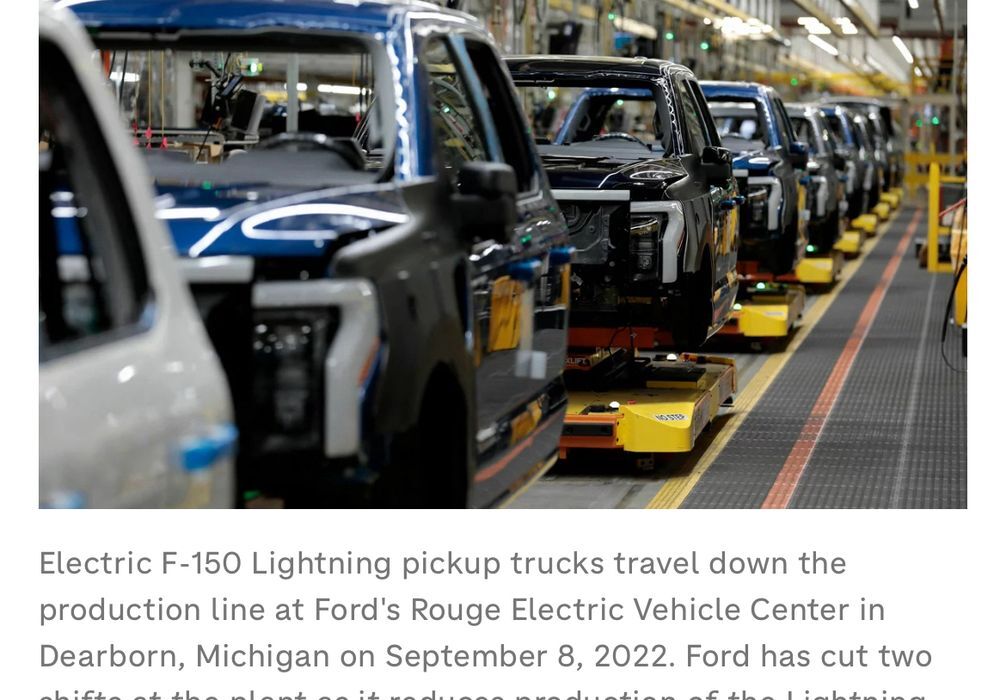I’d love an EV. Unfortunately I can’t afford vehicles that aren’t at least 20 years old. So it’s going to be a while until I can get one.
Not just that, lots of Americans dont own a home with a garage.
What we need are swappable batteries. But those take up a lot of space, they can’t be in giant underground tanks like gas.
Not really. We need mandated accessible charging infrastructure. All rental spaces should be required to provide access to at least one level 1 charging station per rental. Level 1 (regular wall outlet) is enough for just about everyone. You charge overnight and you never need to worry about stopping at some gas station or battery swap station or anything like that. If, for whatever reason, you need more than level 1 then hopefully there will be other options for you, but access to level 1 will solve most of the issues with EVs and rental property.
I’ve seen a few swappable battery concepts but realistically I think a much better direction is just faster charging batteries. Swapping the batteries around seems to be just by side stepping the problem rather than actually solving it
You can only charge a regular chemical battery so fast. There are other ways to store power that you can “charge” faster but that’s basically just fuel cell tech and you can “recharge” faster by just refueling. Those also have their own issues.
Not to mention there is only so fast you can charge something via electricity and still have a regular person be able to safely do it. Megawatt charging stations are being developed but nobody in their right mind is going to let joe schmoe the office window licker handle a megawatt charging cable. And you can only make the electric drive train so efficient (still many times more efficient than an ICE). So for EVs with any decent range there will be a cap on how quickly they can be charged with an electric cable simply because there are practical limits on how much power a safe charger can output and how small a vehicle battery can be.
That’s not to say EVs are a bad idea. We will just need to adapt to the new refueling characteristics. I imagine in the comming years we will start to see trickle chargers poping up basically anywhere people park their cars weather that be curbside or in parking lots/ramps. There will be more opportunities to keep the batteries topped up rather than recharging the whole thing in one sitting like we are currently used to with refueling ICE vehicles.
Swapable batteries will never happen in cars. (might for semi trucks or tractors). The individual cells in a battery are small and car designers want to cram as many in as they can where they fit. Thus the incentive is to make each battery an odd shape around the other things in the car.
Yeah, but standardized swappable batteries would be great for consumers, and ensure a used car market could exist.
A 15 year old car might not be supported by a manufacturer, but if it was a standard for those years there’d be a big enough demand even if it’s a third party that fills the void.
We need to think long term, and cars being junk after a decade ain’t a good long term strategy.
The cells should be individual 18650 which are standard and easy for a tech with the right training to replace. No need for a swap able battery, just repairable is all we need.
Most vehicles are not available as an EV yet. Want a minivan - VW says this summer you can get the first one. Want a truck - has to be the Ford F150 - which is in short supply and only available as a crew cab no long box. Want a car - limited choices and all luxury (except the leaf which is very limited range)
And of course most cars are old - most car buyers don’t even have as many options as the above as EVs are not yet on the used market in as great numbers.
You can buy a PEHV minivan already from Chrysler.
The problem of luxury-only pervades the US car industry right now, and is not restricted to EVs.
Isn’t the Pasifica Plug in famously plagued by major reliability issues, and still has only a thirty mile electric range before you might as well have gone for the cheaper version. Given no small part of a minivan’s expected use if for medium to long road trips, as well as things like shuttling a bunch of kids around after school between houses where your probably not going to have much chance to charge, I wouldn’t exsacly call it a replacement for a proper EV. Better yet, we could even get more than one possible option of which car to buy, like if two or maybe even three different companies had competing products.
Actual use of minivans I see: moving kids around town. 30 miles does that nicely. Road trips are a small fraction of total mileage.
The people I know who own them have been happy.
While it will depend on use case, 30 miles isn’t all that much when the average US commute is 41 miles, and that’s not including that if your moving kids around town your likely going between more than just school work school home, and so will will need more range given the three for four trips on a single charge.
Say for example you start at home, you go five miles to school, another ten to work, ten back from work to school, and your out of battery even before any moving kids aroud town to friends or activities can start. Never mind that the Pasifica lacks a heat pump, so if you live in a place that gets cold your going to be spending a decent slice of that battery on heating.
People tend to charge at work, at least where I am. So it means all-electric except on road trips.
That’s downright amazing.
Ya, around here being allowed to charge at work is pretty rare. I can’t imagine it being more likely when the vehicle doesn’t need to.
Having the option of being all electric period is a lot more useful.
I don’t doubt that it’s more useful in every case other than road trips. But PEHV is pretty good, and it’s what’s on the market today.
i have looked at it, one trim level which isn’t the one I need. The pathetic range means I’e mostly be on gas even for trips around town.
The problem is EVs are not the answer we are all pretending they are. Moving away from the car model altogether is what we need. Offer tax credits to businesses that go full remote. Offer credits for people that get rid of their cars and/or move to a more densely populated area. This is not trickle down climate saving time. This is fucking Hail Mary, spend ourselves to the poorhouse to change things time.
How are EVs not the solution for people who need vehicles?
Everytime I hear this, the response is “we need better public transit, and EVs for all the people who can’t effectively be serviced by public transit”
Which is like sure, if we had more money we could solve both, and many places are trying to solve public transit (but it’s slow and expensive to do right).
EVs are part of the solution. But there are many parts to this solution. Pretending that EVs aren’t needed doesn’t actually help at all.
Yeah, I’m not saying they’re inherently a bad thing. But this is another greenwashing technique We won’t buy our way out of climate change. We need drastic change. Not a shift over, but a complete turnaround. Consumerist solutions are a pipe dream, and they presuppose time we just don’t have.
In the meantime, they’re a distraction. They’re a pacifying technique from the owner class. We need a halt and a turnaround, not a slow shift toward something less harmful.
In an ideal world, yeah, we’d have the time to slow emissions through incremental change. But we are less than a handful of years away from what could very realistically be a major tipping point. And these, I’m sorry, greenwashing pacifications from business titans promising we can continue on our path with some ornamental changes just isn’t realistic. People are gullible and all too willing to take the easy out with climate change. When EV availability struggles a little bit, or the cost goes up, people just keep buying cars. I’ve seen it happen with every single friend I have that’s bought a car. They want an electric vehicle, they’re cost prohibitive or there’s a waitlist, and they all bought ICE vehicles. Continuing on with the car model is at least two steps removed from something even resembling a true step in the right direction. Pumping EVs is of course better than fighting them in favor of ICEs. But it also doubles down on a flawed system. People live forty miles from work in so many places in the US. It’s not nearly unheard of for long commutes. CHANGE THE BASE CONCEPTS, NOT JUST THE ORNAMENTS OF THIS WASTEFUL LIFESTYLE.
WFH. More condensed living. These are the base problems to which EVs are a secondary solution. We don’t have time for eating around the edges. This is my point. Drastic, radical change immediately. That’s what we need. And pacifying people with feel good changes that maintain their comfort is a fuckin cop out.
And that’s just a small part of the problem, the thrust of which is we need to radically change our habits like yesterday. Not alter buying patterns so the stock price keeps going up and we all still get to drive everywhere. Not to mention way too much of our electricity is still coming from nonrenewable sources. It’s almost like just removing ourselves from blame. We can say, “well, it’s not my fault I drive an EV.” Powered by a grid that still relies largely on natural gas and coal, with nuclear and renewables accounting for roughly 40% in the US.
Again, electric cars, in essence, aren’t a bad idea. But it’s way too little and decades too late and I believe their use is slowing and distracting from the radical change we need.
The lack of competitive minivans, hatchbacks, coupes, long-bed trucks, and station wagons really hurts uptake. While crossovers are all the rage for the average consumer, EV adopters trend away from the average, and having a wide selection can make a huge difference when it comes to overcoming the price barrier or difference in capability.
Case in point, I’ve seen motorheads swear they’d never touch an EV with less than 500 miles of range, only to recant the moment they saw a Honda E.
The Chevy Bolt is luxury? Come again?
The Chevy Bolt is no longer in production.
Yes. Discontinued for 2024. They’ll revamp it at some unspecified point in the future, for some unspecified price point.
another exception.
Here’s a link to the NPR article linked in this post for the lazy
The thing that’s keeping me from buying a new EV - apart from price - isn’t the electric. It’s everything else about the car. I don’t like how they look, I don’t like the giant touch screens, I don’t like the gimmicky features that do nothing but add cost.
Then again, I found out today that I’m a “Harbinger of Failure” so maybe it’s a good thing that I’m not buying an EV.
Had meant to post the NPR article. Edited to link directly to it.
Thanks
You’re part of what makes the Fediverse great
Thanks
With a positive comment like that, you both are.
Aw shucks
Don’t forget that they’re ruthlessly collecting and selling your data as well. They’re worse than any other consumer product.
I definitely consider myself a conservationist, but I’ll keep my '98 Grand Cherokee that costs $50 max to fix, thanks.
There’s also an argument that it’s “more green” to keep the car you have until it dies than buy a new electric car.
Edit: Removed misinformation, link to explanation below. https://www.snopes.com/fact-check/corporations-greenhouse-gas/
70% of emissions are industrial and the average citizen have no control over them.
Where the heck you gettin that from?
https://www.snopes.com/fact-check/corporations-greenhouse-gas/
Turns out I was repeating a bit of misinformation steming from a poorly understood article.
https://www.snopes.com/fact-check/corporations-greenhouse-gas/
Turns out I was repeating a bit of misinformation steming from a poorly understood article.
Removed by mod
The only Subaru EV I can find is the Solterra, and it has all the same problems: I don’t like the way it looks, I don’t like the giant touch screen, and I don’t want or need the driver assist features.
Can they just put an EV drivetrain into an 2003 WRX bugeye hatchback for me? And keep the stickshift.
Removed by mod
Yes and I don’t want that car either.
deleted by creator
I don’t have to because I never said I didn’t like the electric, said I don’t like the rest of the car.
Removed by mod
They didn’t make it weird in any way really.
My dude, they were so dedicated to making it weird that they gave it no glove compartment.
I’d be down to get one if I could afford it. Also if I could charge it anywhere. As it currently stands I’m happy getting 35mpg in my little Ford Fiesta.
Imo, it’s because EVs are dumb, expensive, and so far inefficient due to how many batteries are needed for the cars vs how far they can go on a single charge.
Having less cars on the road in general would do more to cut carbon emissions - EVs should replace fossil-fueled cars, yes, but we should be advocating for more public transit and alternative forms of transit like walking and biking before looking towards replacing regular cars with EVs.
I get the appeal of saying something provocative like “EVs are dumb” (which could be initially interpreted as an advocacy for ICE cars), and then clarifying your position. Makes for an interesting comment.
However, it’s a technically incorrect way to phrase it. Buses, for example, can be ICE or electric. It’s not dumb to have public transit electric. You’re (correctly) advocating for public transit over personal vehicles, but you shouldn’t frame it as electric being a negative. In both personal and public transportation, electric tends to be far better. The only exception atm is for longer trips. Even then though, having a 20 minute break to charge every 300 miles isn’t terrible for humans as we get to stretch our legs for a bit, and it’s not so much longer than a 3 minute break every 400 miles.
Overall, no EVs are not dumb, they’re the future of both personal and public transportation. We should lean towards public, but that public should be electric.
Listen, I am a huge urbanist, would love to see the US and the world transition to car-alternative transit modes. The reality is, cars are not disappearing. Even in the most transit friendly countries, cars still make up an enormous portion of the modes of travel. We need EVs as much as we need alternative modes to be feasible.
I’m gonna post this link to a former comment of mine, since this subject comes up a lot. Neither EVs nor public transit is a magic bullet.
The efficiency of public transit depends on ridership; nowhere in the world does it actually achieve 100% occupancy for more than a few minutes at a time, and nothing is more wasteful than a train running a circuit with only one passenger. At least by my calculations, it would take an average occupancy rate increase of 1.6x (for electric light rail) to 2.4x (for electric busses) over pre-pandemic levels for US public transit to reach parity with EVs, both in terms of electricity per passenger mile and tons of raw material per capita (such as steel, aluminum, copper, glass, and plastic). We’d need higher occupancy than the trains in Europe and the busses in Taiwan. Whether or not that’s geographically possible in North America is an open question.
Ebikes are great, no question there, but thanks to parasitic drain in cheap chargers, they use 1/3rd the energy a typical EV does (kWh per passenger-mile, adjusted for occupancy but not speed), when they should use only 1/10th. That’s a problem I expect to see solved in the next year or so, but it’s a great reminder that nothing runs on magic.
As I say in the linked comment, public transit has critical advantages in the fields of urbanism and human-centric city design. I like trains and busses, and I vote for them every chance I get, it just bothers me when people conflate these advantages with environmental impact.
More work from home would help too
I’d get an electric car if I could charge it easily. Right now EV ownership is coupled to home ownership and mass adoption will never happen while this is the case.
If my apartment complex installed EV chargers in our parking lot, I’d be a lot more willing to get one. I ain’t spending 8 hours a day twiddling my thumbs in a grocery store parking lot just to drive between work and home.
I ain’t spending 8 hours a day twiddling my thumbs in a grocery store parking lot just to drive between work and home.
What are you talking about? New electric vehicles today can fast charge to 80% in 20 minutes or less. For the amount of driving that most people do, that’s more than enough. You’d likely be able to go a few days between charges, and you’re probably going to the grocery store anyways in that time. This is a poor excuse not to get an electric vehicle.
Sadly it isn’t that simple. Most grocery store or similar charging stations (at least around me) are level 1 or 2 (levels described in this article). That means you get roughly 2-4 miles per hour of charging or 12-32 miles per hour of charging (most being the lower).
While there is level 3 fast charging (what you refer to) , they are less common and that assumes your car is compatible (as like phones, not all support fast charging).
The fact all of this is generally unknown by the public is why buying an EV is so hard. You need to know what charging plug your car takes, what levels of charging it can use, as well as if the charges around you support your car at levels you want. It’s why I went hybrid rather than phev/EV recently.










